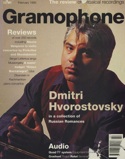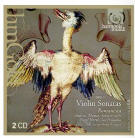Texte paru dans: / Appeared in:
|
|
| "The range of super-sensitive nuance from Romanesca , as a wllole , and Manze's distinctive virtuosity put this amongst the finest baroque chamber music to have appeared in recent years." | |
|
Outil de traduction (Très approximatif) |
|
|
Reviewer: Jonathan Freeman-Atwood
The tercentenary of Biber's death was marked by a number of important releases last year. Two different Requiems from Pickett (L'Oiseau Lyre, 6/94) and Koopman (Erato, 9/94) spring to mind, as does a fine issue of 'trio' so natas for scordatura violins, posthumousl y published under the title Harmonia arrijiciosa-ariosa (Chandos, 11/94). This new recording of Biber's set of eight sonatas dating from 1681 represents one of the more extraordinary examples of neglect in recent recording hi story ; these works, incidentally, are almost certain to be the pieces which caused Jacob Stainer and Charles Burney to proclaim Biber as the outstanding virtuoso of his day. Whilst the more famous Mystery Sonaras have quickly found friend s with their touching cameo-representations of the 15 Mysteries , the 1681 set is still largely unknown amongst players and listeners alike. Yet what is immediately noticeable from this premiere recording of the sonatas (all the miscellaneous extra pieces have appeared before) is that Biber is not only a legendary virtuoso , probably never bettered in the seventeenth or eighteenth centuries, but one of the most inventive composers of his age: bold and nash certainly but also elusive, mercurial and mysterious.
The majority of the works comprise preludes, arias and variations of an unregulated nature: improvisatory preludes over naked pedals and lucid arias juxtaposing effortlessly with eccentric rhetorical conceits are mixed up in an unpredictable phantasm of contrast, and yet at its best it all adds up to a unified structure of considerable potency. Whether Biber consciously manipulated his place in musical history is arguable. Could he possibly have realized that his uniqueness depended on being around at the cusp of established generic forms ('sonata' in Biber's day didn 't mean anything specific), just before tonality and the doctrine of affections had become standardized and whilst being at the fulcrum, benefiting from an age of free vocalization and fantasy of an earlier age?
Whatever the philosophical key to Biber's intangible and unstable world may be, Andrew Manze is the protagonist par excellence for music which requires a notable degree of considered response to complement the adventurous spirit of the virtuoso. In short, this is masterful playing in which Manze has enough confidence in his subject not to overcharacterize Biber's volatile temperament. Hence the preludes are often sweet and restrained (in the Sonata No.3 , drifting dreamily up to a high F sharp) and yet often there is also a held-back, almost smouldering quality, which is skilfully pitched against the free-wheeling energy of the fast music. The range of expression is indeed a constant joy; even those rare moments when Biber runs out of ideas are elevated by the violinist's technical assurance, his conviction in the composer's sense of direction (which ensures the success of such disparate movements as the Varialio of Sonata No.3) and the continuo's deft and discreet commentary. Perfectly argued sentences, as in the dark-toned foreboding of Sonata No.2, are another strong feature, especially in the declamatory 'recitatives ' where the organ matches the intense mood set by the soloist. Sonata No.5 is certainly in the same league, a superbly inventive work where Manze and a chameleon-like continuo revitalize the music in a full palette of colorific variation. If Manze's expressive slides are a little too predominant in the doleful chromatic opening Sonata No.6, he again provides nobility in a work of impressive structural integrity. Sonata No.4 transports the listener momentarily into a world of more courtly manners and decorum only to be dragged back to the rollicking folk idiom which lies at the heart of Biber's perspective.
Colour and the interactive melodic
and textural blend of Manze, Toll and North are reconstituted for the amusing
programmatic solo, Sonata representativa. Reinhard Goebel's zoo of
animals is perhaps more fractious and caged but Manze's creatures are no less
vociferous, with gipsy-style shifts giving the whole a wonderfully spontaneous
deliverance. These are, then , performances which exhibit sustained playing of a
very high order. The range of super-sensitive nuance from Romanesca , as a
wllole , and Manze's distinctive virtuosity put this amongst the finest baroque
chamber music to have appeared in recent years. |
|
|
|
|
|
Cliquez l'un ou l'autre
bouton pour découvrir bien d'autres critiques de CD |
|




